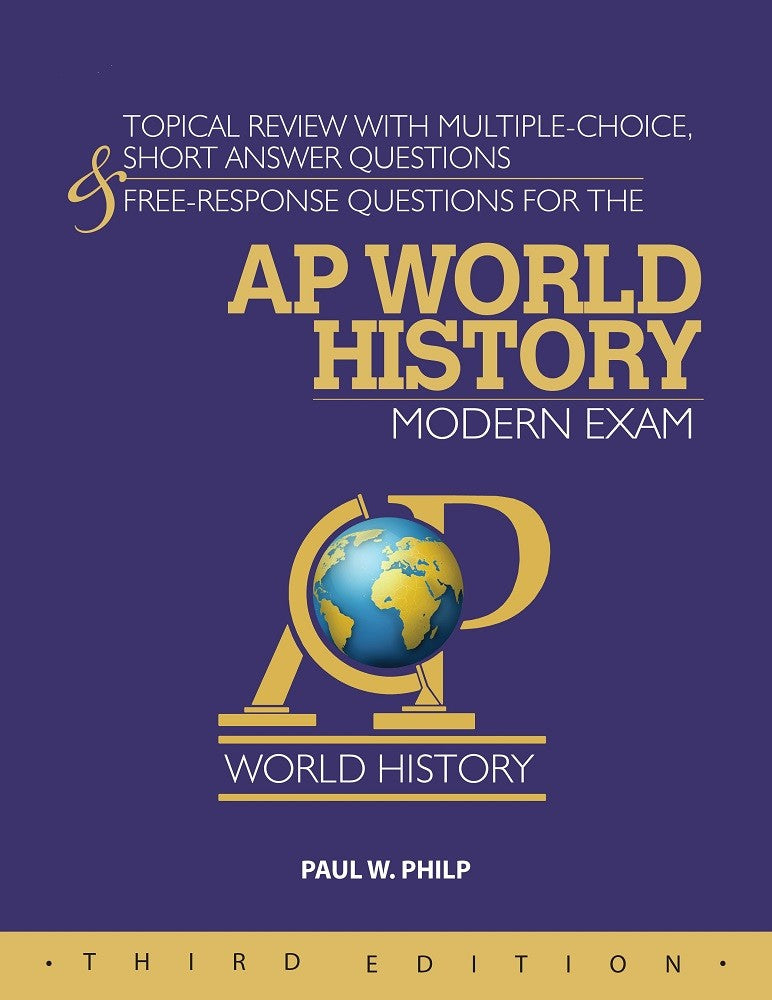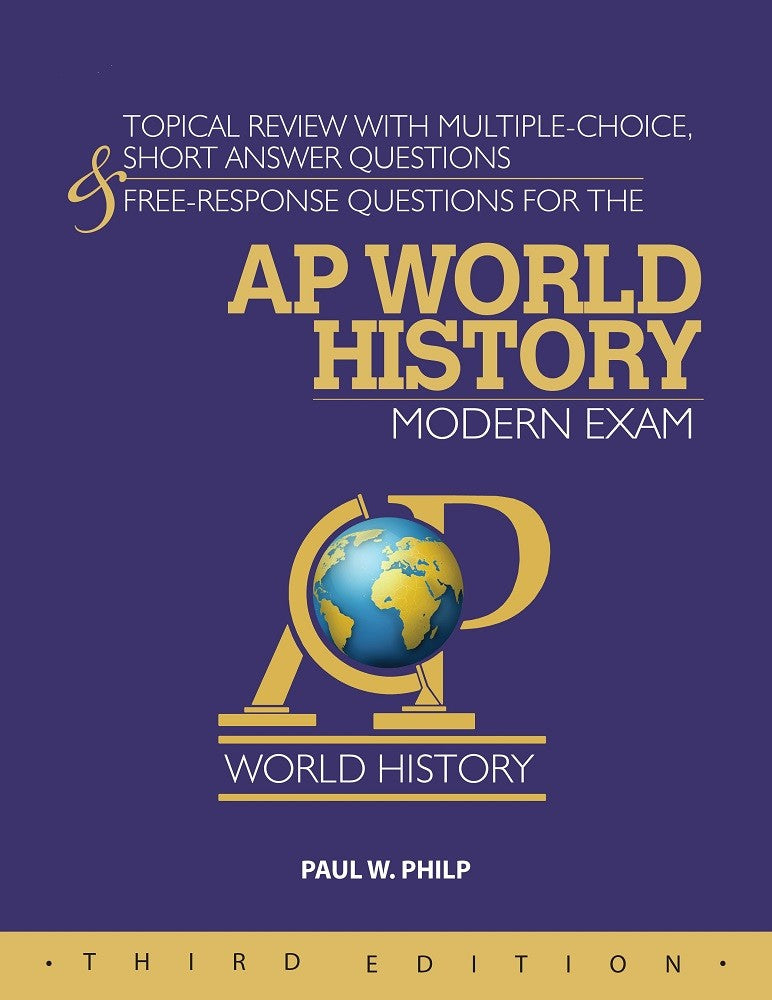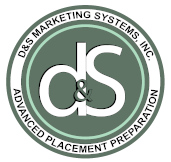FREE SHIPPING for online orders Same Day shipping for most orders placed before 2PM EST
AP DISCIPLINES
OTHER MATHEMATICS PUBLICATIONS
**NEW** TOPICAL REVIEW WITH MULTIPLE-CHOICE, SHORT ANSWER QUESTIONS, AND FREE-RESPONSE QUESTIONS FOR THE AP WORLD HISTORY: MODERN EXAM - 3RD ED.
**NEW** TOPICAL REVIEW WITH MULTIPLE-CHOICE, SHORT ANSWER QUESTIONS, AND FREE-RESPONSE QUESTIONS FOR THE AP WORLD HISTORY: MODERN EXAM - 3RD ED.
NEW

More Info
More Info
BRAND NEW EDITION - COMPLETELY NEW MATERIAL WITH OVER 600 PAGES OVERVIEW OF THE BOOK Part I summarizes the course, historical periods, units of study, themes, historical thinking processes, skills and forms of assessment essays, rubrics, and multiple-choice questions necessary to succeed on the May AP World History Modern exam. Part II will cover the nine units and four historical periods laid out in the Course Examination and Description for AP World History Modern. I summarize important information and content that you should know. The order of presentation will match the sequencing of units, topics and subtopics in the Course Examination and Description. Included will be key vocabulary or terms. These words will be in bold black. Definitions will be presented contextually. Each unit will include ten to fifteen multiple-choice questions and three Short Answer Questions at the end. One Long Essay Question and one Document-Based Question will follow each historical unit these will cover the designated type of essay for each unit as laid out by the College Board's Course Exam and Description. Part III will include three full practice exams. There will be fifty-five multiple-choice questions, four groupings of SAQ prompts, three Long Essay Questions, and one Document-Based Question. The Appendix after Part III covers writing the three types of AP World essays. The appendix covers writing tips for the Short Answer Question, the Long Essay Question and the Document Based Question and includes functional rubrics. The Appendix covers each of the indicators on the rubrics with commentary and examples. There are also working outlines on how to structure essays, too. TOPICS OF THE DOCUMENT-BASED ESSAY QUESTIONS 1. Unit 1: State Formation, c. 1200 to c. 1450 2. Unit 2: Trading Alliances Compared: The Swahili and the Hansa 3. Unit 3: Comparison of Land-Based Empires 4. Unit 4: Economic Developments Impact Social Structures, 14501750 5. Unit 5: The Industrial Revolution Changes World Societies, 17501900 6. Unit 6: Evaluation of the Effects of Imperialism, 17501900 7. Unit 7: Causes of Conflicts, 1900 to Present 8. Unit 8: Effects of the Cold War in the Eastern and Western Hemispheres 9. Unit 9: Science and Technology Brought Changes since 1900 10. Exam 1: Identity Creation in the African & Black African Diasporic World since 1750 11. Exam 2: Amerindian Reactions to European Contacts, 14921800 12. Exam 3: Human Responses to Pandemics & Epidemics, 1450 to 2001 Each class order is accompanied by a FREE Teacher's Manual that contains explanations for all multiple-choice questions and scoring guidelines for all essay prompts in the book. Separate student answer keys for the multiple-choice section are included with each book. You no doubt have high standards when it comes to choosing the best AP World History book for your students. The questions in our book are as difficult and demanding as your students will find the actual examination. Your students will be thoroughly prepared for the examination. Why not give your students the edge?
Author
Author
The author of the book is Paul Philp. Paul received both a Bachelor of Science in Foreign Service and a Certificate of German Public and International Studies from Georgetown University in Washington, DC. He earned his State of Texas certificate in secondary education in composite social studies from the University of Texas in Dallas. His Master of Art's degree in Modern History is from Texas A&M University Commerce. He was one of the original consultants and readers for AP World History beginning with the generation of syllabi and two years of training with the original chief reader and members of the test development committee. After thirteen years as a classroom teacher, Paul became an administrator of curriculum and special educational programs in both public and private schools for ten years. Paul has taught Pre-AP World Geography, AP European History, US History as well as topics within AP Macro-Economics and AP Art History. He is a presenter for the College Board, has written multiple choice questions for the Advanced Placement World History exam, and is a national grader of the Advanced Placement World History essays. Paul taught World Civilizations and American History at the local community college for nine years. Currently he is writing the curriculum for and teaching courses in Latino and Mexican-American studies for a Plano Independent School District at the three senior high schools. His publications include the study guide for Peter Stearn's Advanced Placement textbook, 3rd and 4th editions, World Civilization, and the Teachers' Guide to Jerry Bentley's Traditions and Encounters, 6th Edition. He co-authored a collaborative study of the Industrial Revolution in an international, world historical context with the Woodrow Wilson Institute at Princeton, New Jersey, and Document Based Questions in both European and World History. Paul is a past associate editor for the Encyclopedia of World History published by Berkshire Publishers of Boston. In 2020, he published a paper Why Start World History in 1200 CE? in World History Connected.
Testimonials
Testimonials
Here is what some of your colleagues had to say about our first edition AP World History book:
The books are great. They have helped my students tremendously."
Luann Bloodworth / Lee County HS, Leesburg, GA My students found the charts helpful in our reviews. I like the fact that the answers are not in the book."
Jennifer C. Meade / Fort Walton Beach High School, Fort Walton Beach, FL "I like the way the book aligns the review text with the six themes of AP World History. The extensive use of review icharts is particularly helpful."
Gwen Palace / Booker T. Washington High School, Tulsa, OK
10 BOOKS MINIMUM
SKU: ISBN #: 1-934780-68-5
| Quantity | Price per book |
|---|---|
| 10 - 15 books | $24.95 |
| 16 - 25 books | $23.95 |
| 26 - 50 books | $22.95 |
| over 50 books | $21.95 |
| Quantity | Price per book |
|---|---|
| 10 - 50 e-books | $18.50 |
| over 50 ebooks | $17.50 |
ALL E-BOOKS PURCHASED CAN BE VIEWED FOR ONE (1) YEAR FROM THE DATE THE E-BOOK ACCESS CODES ARE ACTIVATED
If you plan to use a purchase order and need an order form, please click here
Couldn't load pickup availability

